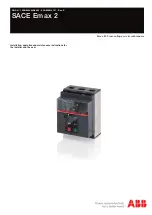
will rotate so as to block the shutter interlock pin. This
prevents the shutter from returning to its closed position
and releasing the trip plate, if the levering crank is removed.
Thus, if a closing operation is attempted during this part of
the travel, a trip-free operation occurs and the breaker con-
tacts do not close. Note that this is true for either direction
of breaker travel so that no load is made or broken at the
disconnecting contacts.
When the breaker gets to the TEST position, a slot in the
interlock cam allows free movement of the shutter interlock
pin, and the shutter returns to its closed position when the
levering crank is removed. The levering device arms are now
almost vertically downward.
Figure 4-12c shows the DISCONNECT position. Here the
cam also rotates so as to block the shutter interlock pin
while the breaker is between positions, thus holding the
shutter open. When the exact position, as shown on the
indicator, is reached, the shutter will close when the levering
crank is removed. The levering arms will be approximately 40
degrees below the horizontal.
a. Connect Position
c. Disconnect Position
b. Test Position
Levering Device Arms
Shutter
Shutter Interlock Pin
Interlock Cam
d. Remove Position
Figure 4-12 Shutter, Interlock Cam and Levering Device Arms Relationship
Effective July 2010
Instructional Book
IB694C694-03
43
eaton corporation
www.eaton.com













































